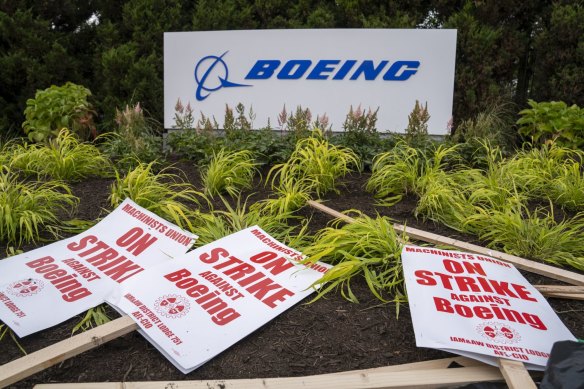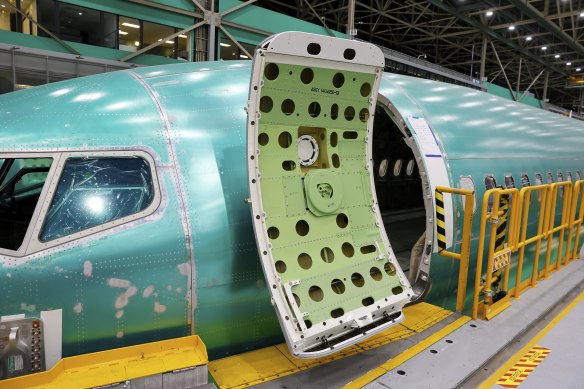This was published 9 months ago
Opinion
Boeing is bleeding billions, but it is too big to fail
Stephen Bartholomeusz
Senior business columnistFew, if any, companies confronting the existential challenges Boeing is experiencing would be able to contemplate raising more than $50 billion of new capital. Boeing’s creditors and shareholders, however, know that it is too big and strategically important to the industry and America to be allowed to fail.
On Tuesday, the embattled aircraft manufacturer said it had arranged a $US10 billion ($15 billion) new credit facility with its banks and had filed a shelf registration with the Securities and Exchange Commission that would enable it to raise a further $US25 billion in equity and/or debt.

Boeing’s new chief executive, Kelly Ortberg, has made it clear that retaining its investment grade status is a priority.Credit: Bloomberg
The filing came only days after Boeing said it expected to report a loss of more than $US6 billion for the third quarter after incurring operating losses of $US1.3 billion and taking $US5 billion of charges against its defence and commercial aircraft businesses.
It also said it planned to cut its workforce by 10 per cent, or about 17,000 employees, over the next few months.
With a strike by 33,000 of the company’s machinists now into its fifth week, production of its best-selling 737 Max, 767 and 777 aircraft at a near standstill, and credit ratings agency S&P Global warning that its losses could reach $US1 billion a month, Boeing is under acute pressure.
With only about $US10 billion of cash or cash equivalents at June 30, on the brink of a credit ratings downgrading to junk status, and the strike exacerbating its inability to deliver aircraft to its customers affected by the 2018 and 2019 crashes of its 737 Max planes, Boeing might normally be considering fleeing to the protection of the Chapter 11 bankruptcy regime.
Boeing isn’t, however, a normal company. Boeing and Europe’s Airbus dominate global commercial aircraft manufacturing. Boeing is America’s only major manufacturer of large airliners and also has significant defence contracts – they generate close to 40 per cent of its revenues.
It is, for the US, too big and too strategic to be allowed to fail.
That’s why there are suggestions that Boeing’s fixed price contracts with the US Defence Department might be renegotiated.
The bulk of those contracts were entered into before the pandemic upended supply chains and sparked a massive surge in the US inflation rate that rendered them unprofitable.

A continuing strike is just one of many problems for Boeing.Credit: Bloomberg
Boeing lost $US2.4 billion in its defence, space and security division in the September quarter. That’s unsustainable, and the pressure on the US government to help bail Boeing out by putting profit back into those contracts is obvious.
The national economic and security implications of Boeing’s financial predicament are why its bankers and shareholders would be prepared to lend or invest new money in what would otherwise be a failing enterprise. They know Boeing won’t be allowed to fail.
The $US10 billion credit facility that a consortium of America’s largest banks arranged relieves near-term liquidity pressures and, by assuaging concerns about Boeing’s survival and demonstrating the support of its banks, should make it easier to raise the massive infusions of new equity and debt its SEC filing envisages.
If Boeing can raise fresh equity, it might also avert the threat of a ratings downgrading that would exclude most of its $US50 billion-plus of long-term debt from investment-grade indices. Some institutions can’t hold anything other than investment-grade debt. A downgrade would restrict the company’s access to debt and add to its cost.
Boeing’s new chief executive, Kelly Ortberg, has made it clear that retaining its investment grade status – avoiding having its debt classified as junk debt – is a priority.
The rate at which Boeing is burning cash is an outcome of its deeper problems. The crashes of its planes and other incidents – like the door that fell off during a take-off in January – revealed major quality control failures in its production processes, and have resulted in a massive blowout in its ability to deliver planes to its customer airlines.
On Friday, Boeing said deliveries of its 777X model would be further delayed, to 2026. First deliveries of the plane, Boeing’s largest wide body aircraft, were originally scheduled to occur in 2019.
Boeing’s failings have caused chaos for its customers and their fleet planning, forcing them to spend heavily to update existing aircraft to extend the lives of their fleets while they wait – and wait – for Boeing to meet its contractual commitments.

Boeing has a backlog of orders for almost 5500 planes, with estimates that there is about $US500 billion of revenue trapped in those delayed deliveries.Credit: AP
Airlines like Emirates, Singapore, Qatar and Lufthansa are all in the queue for the 777s – Emirates alone has ordered more than 200 planes. In fact, Boeing has a backlog of orders for almost 5500 planes, with estimates that there is about $US500 billion of revenue trapped in those delayed deliveries.
Airbus has benefited from Boeing’s woes, but doesn’t have the capacity to capitalise significantly on the opportunity the problems have presented.
It’s also had some production issues of its own, and has lowered its aircraft production target for 2024 from 800 to 770, citing supply chain disruptions. It will struggle to meet even that reduced target. Airbus, too, has a swelling backlog of orders.
China’s Comac, whose narrow-bodied jets flew commercially for the first time last year, has global ambitions and is part of China’s five-year plans to dominate particular advanced manufacturing sectors.
But Comac is heavily reliant on US and European suppliers for key components, and lacks the international networks of parts and service centres of Boeing and Airbus, which aren’t easily or quickly replicated. China’s ambitions are long-term.
Thus, Boeing’s problems – which most blame on its acquisition of McDonnell Douglas in 1997 and its adoption of that company’s emphasis on profit over engineering excellence and safety – are an industry-wide problem.
Airlines have nowhere else to go and therefore no option but to refurbish their existing ageing fleets while waiting several more years, at least, for their new planes.
The Business Briefing newsletter delivers major stories, exclusive coverage and expert opinion. Sign up to get it every weekday morning.